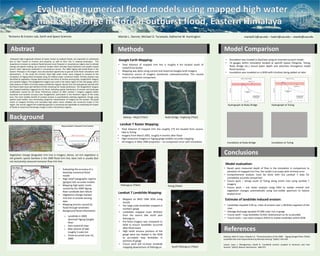
symposiumposter2015
- 1. Mariah L. Danner, Michael D. Turzewski, Katherine W. Huntington Abstract Background Methods Model Comparison Conclusions References Infrequent high-magnitude releases of water, known as outburst floods, are important to understand due to their hazard to humans and property, as well as their role in shaping landscapes. This importance increases as outburst floods become more frequent in mountainous regions due to climate change and glacial melting, yet numerical models which simulate flood hydraulics and predict hazard haven’t been rigorously evaluated in mountainous terrain. The 2000 Yigong dam-break-flood in the Eastern Himalaya is the largest, best documented opportunity to ground truth flood simulations with observations. In this study the trimline, flood high water marks, were mapped to compare to the inundation of Yigong flood simulated using 2D shallow water numerical model. Trimline position was identified by vegetation change determined by two kinds of remote sensing data, GoogleEarth imagery and Landsat imagery. The GoogleEarth imagery was used in the Indian region of the river-gorge, with a total distance of 564m of trimline being confidently mapped. Results from the data gained overlaid with the flood model show well defined trimline matching the model predictions. The GoogleEarth imagery also showed landslides triggered by the flood, indicating spatial distribution of erosion and landscape modification caused by the flood. Preliminary analysis of 2001 Landsat 7 imagery suggests better resolution and location accuracy than GoogleEarth, particularly in the Northern region of the study area. The most notable benefit of Landsat analysis is quantitatively isolating vegetation change using specific band widths, thus eliminating subjective interpretation of imagery by the analyst. The good match of mapped trimlines and simulated high water marks validates the numerical model in this region. Our results suggest this modeling approach is promising and applicable to evaluating the impact of floods on hazard and landscape change in other mountainous regions. Delaney, Keith B, Evans, Stephen G. “Characterization of the 2000 Yigong Zangbo River (Tibet) Landslide Dam and Impoundment by Remote Sensing” (2001): 543-559 Larsen, Isaac J, Montgomery, David R. “Landslide erosion coupled to tectonics and river incision” (2012): Nature: Geoscience : 468-473 Vegetation change designates trim line in imagery. Dense, sal rich vegetation is old growth; sparse bamboo is the 2000 flood trim line; bare rock is usually (but not exclusively) seasonal monsoon flow trim line. Boleng – Mopit (Tibet) Nubo Bridge, Yingkiong (Tibet) Pailongcun (Tibet) Tuting (Tibet) South Pailongcun (Tibet) Hydrograph at Nubo Bridge Hydrograph at Tuting Inundation at Nubo Bridge Inundation at Tuting Google Earth Mapping: Landsat 7 Raster Mapping: Landsat 7 Landslide Mapping: • Evaluating the accuracy of a GeoClaw numerical flood model • High relief topographic regions (gorges) lack accurate models • Mapping high water marks caused by the 2000 Yigong River Landslide dam failure • Vegetation change marked trim line in remote sensing data • Mapping erosion caused by flood through landslides • Background flood information: o Landslide in 2000 dammed Yigong Zangbo River o Dam lasted 62 days o Max volume of lake roughly 3 cubic km o Flood occurred June 10, 2000 Tectonics & Erosion Lab, Earth and Space Sciences mariad11@uw.edu – kate1@uw.edu – zewski@uw.edu • Total distance of mapped trim line is roughly 4 km located south of India/China border • Mapping was done using current and historical Google Earth Imagery • Projection source of imagery sometimes unknown/unclear. This caused error in simulation comparison. • Total distance of mapped trim line roughly 172 km located from source lake to Tuting • Imagery from March 2001, roughly 4 months after flood • High resolution imagery in Yigong gorge enables accurate mapping • All imagery in WGS 1984 projection – no comparison error with simulation • Mapped on WGS 1984 DEM using ArcGIS • Ten large scale landslides mapped in northern gorge • Landslides mapped cover 38.81km from the source lake south past Pailongcun • Pre-flood imagery was compared to DEM to ensure landslides occurred after flood event • High relief, sinuous portions of the gorge were too shaded in the DEM to accurately map landslides in portions of gorge • Future work will increase landslide mapping downstream of Pailongcun • Simulation was created in GeoClaw using an inverted tsunami model • 14 gauges within simulation located at specific places (Tangmai, Tuting, Nubo Bridge etc.) record water depth and velocities throughout model flood duration • Inundation was modeled on a DEM with trimlines being added on later • Based upon measured depth of flow in the simulation in comparison to elevation of mapped trim line, the model is accurate with minimal error • Comprehensive analysis must be done with full Landsat 7 data for completely accurate comparison • Future work – remap south of Tuting along entire river using Landsat 7 imagery • Future work – use raster analysis using ENVI to isolate mineral and vegetation changes automatically using non-visible spectrum to reduce analyst error • Landslides equaled 2.94 sq. miles of erosion over a 38.81km segment of the river • Average discharge equaled 47,000 cubic m/s in gorge • Future work – map landslides further downstream as far as possible • Future work – use raster analysis (ENVI) to isolate landslides within DEM Model evaluation: Estimate of landslide induced erosion: